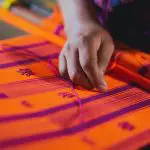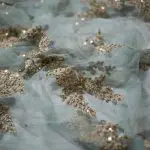Are you looking to create custom designs on light-colored fabrics using dark transfer paper? While it may seem counterintuitive, it is possible to use dark transfer paper on light fabric. However, there are certain factors to consider and steps to follow to ensure successful results.
Transfer paper is a popular method for transferring designs onto fabrics, especially for those who do not have access to a heat press or screen printing equipment. Dark transfer paper is specifically designed for use on dark fabrics, as it contains a white base layer that allows colors to appear vibrant and opaque. However, using dark transfer paper on light fabrics presents a unique challenge as the white base layer can show through, altering the appearance of the design.
Table of Contents
Understanding Transfer Paper
You might be wondering, can you use dark transfer paper on light fabric? Well, the answer is no, you can’t because the paper is specifically designed to transfer opaque designs onto dark fabrics.
Transfer paper is a special type of paper that allows you to transfer an image from one surface to another. It is commonly used in arts and crafts, as well as in the printing industry.
Transfer paper comes in different types, including dark transfer paper and light transfer paper. Dark transfer paper is designed to be used on dark fabrics, while light transfer paper is designed to be used on light fabrics.
The reason for this is that dark transfer paper has a white or opaque background that allows the design to stand out on dark fabrics. On the other hand, light transfer paper has a transparent background that allows the design to blend in with the light fabric.
The Challenge of Using Dark Transfer Paper on Light Fabric
Although it presents a difficult task, using transfer paper meant for darker fabrics on lighter fabric can be a challenge. The reason is that dark transfer paper is designed to work by allowing the white portions of the image to remain unprinted, thus taking on the color of the fabric.
However, when the transfer paper is used on a light fabric, the image will end up being washed out and difficult to see. To combat this issue, there are a few things that can be done to help make the transfer stand out more.
One option is to use a white background on the image to give it more contrast against the light fabric. Another option is to print the image multiple times to make the colors more vibrant. But be cautious of using too much ink, as this can cause the transfer to smudge or bleed.
Overall, using dark transfer paper on light fabric is not impossible, but it does require some extra effort and attention to detail. By adjusting the image and printing multiple copies, you can create a successful transfer that will stand out on the light fabric. It may take some trial and error, but with patience and practice, you can achieve the desired result.
Factors to Consider Before Using Dark Transfer Paper on Light Fabric
Before attempting to use dark transfer paper on a lighter fabric, it’s important to consider various factors that can affect the outcome of your transfer. Here are some things to keep in mind:
-
Fabric color: Even if you’re using dark transfer paper, the color of the fabric you’re transferring onto can still impact the final result. Lighter colored fabrics may not be able to fully showcase the design, and may cause it to appear faded or washed out.
-
Design complexity: The more complex your design, the more difficult it may be to transfer onto a lighter fabric. Fine details and intricate shapes may not show up as well, and can result in a less defined final product.
-
Transfer paper quality: Not all transfer papers are created equal. Some may not be suitable for use on lighter fabrics, or may require different application techniques. Be sure to read the instructions carefully before attempting to use any transfer paper.
-
Application method: The method you use to apply the transfer can also impact the final result. Some transfer papers may require higher heat settings or longer pressing times, while others may need to be applied using a specific type of iron or heat press.
By taking these factors into consideration, you can make an informed decision about whether or not to use dark transfer paper on a lighter fabric. With the right materials and application techniques, you can achieve a high-quality final product that showcases your design beautifully.
Steps for Using Dark Transfer Paper on Light Fabric
Get ready to create your own custom designs on lighter fabrics with these simple steps for using dark transfer paper! First, choose your design and print it on the dark transfer paper. Make sure to mirror the image before printing so that it appears correctly on the fabric.
Next, preheat your iron to the highest setting without steam. Place the transfer paper with the printed side facing down onto the fabric and apply heat and pressure with the iron for about 20-30 seconds. Be sure to press firmly and move the iron in circular motions to ensure even heat distribution.
Let the transfer cool for a few seconds before gently peeling off the paper backing. Your custom design should now be transferred onto the light fabric.
Wash the garment inside out in cold water and hang or lay flat to dry to ensure the transfer lasts as long as possible. With these easy steps, you can use dark transfer paper on light fabric and create unique, personalized designs for any occasion.
Tips for Successful Results
For the best outcomes, it’s crucial to follow these expert tips and tricks when creating your custom designs on lighter materials with dark transfer paper.
Firstly, make sure to trim the transfer paper as close to the design as possible. This will prevent any excess paper from showing on the final product. Additionally, use a flat, hard surface when pressing the transfer onto the fabric. This will ensure that the transfer adheres evenly and without any wrinkles.
Secondly, it’s important to choose light-colored fabrics that are made of 100% cotton or a cotton/polyester blend. These fabrics work best with dark transfer paper and will provide the most vibrant and long-lasting results. Avoid using fabrics that are too thin or stretchy, as they may not hold up well with the transfer process.
Lastly, always follow the instructions provided by the transfer paper manufacturer. Each brand may have slightly different instructions and settings for their transfers. By following these tips and the manufacturer’s instructions, you can ensure that your custom designs will come out looking professional and vibrant on lighter materials with dark transfer paper.
Alternatives to Dark Transfer Paper
Looking for other options? Check out alternative transfer methods that can produce stunning results on a variety of materials.
One option is using heat transfer vinyl (HTV), which involves cutting out designs from vinyl sheets and applying them to fabric using heat and pressure. HTV is available in a range of colors and finishes, including metallic and glitter, and can be used on both light and dark fabrics.
Another alternative is screen printing, which involves creating a stencil and using it to apply ink to fabric. This method is best suited for larger quantities and designs with fewer colors, but can produce vibrant and long-lasting results. While screen printing requires some specialized equipment, there are also DIY kits available for beginners.
You can also try sublimation printing, which involves using heat to transfer dye onto fabric. This method produces high-quality, full-color designs and can be used on a variety of materials, including polyester and other synthetic fabrics. However, it does require specialized equipment and can be more expensive than other methods.
Overall, there are many alternative transfer methods to explore if you’re looking to create custom designs on fabric. Whether you choose HTV, screen printing, or sublimation, be sure to do your research and choose the method that best fits your needs and budget. With a little experimentation, you’re sure to find a technique that produces stunning results.
- China Carbon Kevlar Fabric Wholesale: Cost-Effective Sourcing - June 21, 2025
- Carbon Kevlar Fabric in Canada: Availability and Supplier Reviews - June 21, 2025
- Carbon Kevlar Color Fabric: Aesthetic Options for Custom Projects - June 21, 2025





